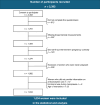Age at First Full-term Pregnancy and Other Reproductive Factors Are Associated with Mammographic Breast Density in Postmenopausal Women: A Study in Flanders, Belgium
- PMID: 39835404
- PMCID: PMC11803437
- DOI: 10.1158/2767-9764.CRC-24-0561
Age at First Full-term Pregnancy and Other Reproductive Factors Are Associated with Mammographic Breast Density in Postmenopausal Women: A Study in Flanders, Belgium
Abstract
Abstract: This study evaluated the association between age at first full-term pregnancy (FFTP) and mammographic breast density (MBD) in postmenopausal women. A total of 1,034 women, ages 50 to 69 years, were recruited from the Flemish (Belgium) population–based breast cancer screening program. Participants completed a questionnaire on lifestyle and reproductive factors. From mammography, we assessed the percentage glandular tissue of the total breast volume (GLAND), the volumetric breast density (VBD), and the Breast Imaging Reporting and Data System (BI-RADS) density classification. For statistical analysis, we used the piecewise linear regression model. The average age at FFTP was 26.1 years. Among women with an FFTP > 25.7 years, an each year increase in FFTP age was associated with a 1.17% increase in GLAND [95% confidence interval (CI), 0.20%–2.46%; P = 0.041] and a 1.45% increase in VBD (95% CI, 0.18%–2.75%; P = 0.026). Similarly, the odds of a higher BI-RADS classification increased by 5.0% (95% CI, 0.0%–11.0%; P = 0.059) for each year increase in FFTP age after 25.7 years. For every year delay in age at menarche, a 2.48% higher GLAND (95% CI, 0.43%–4.57%; P = 0.017) and a 2.45% higher VBD (95% CI, 0.38%–4.56%; P ≤ 0.020) were observed. Ever use of oral contraceptive resulted in a 12.24% decrease in GLAND (95% CI, −20.90% to −2.63%; P = 0.014) and a 13.48% decrease in VBD (95% CI, −22.1% to −3.91%; P = 0.007). MBD is significantly higher when FFTP takes place after 25.7 years. Later age at menarche is associated with higher MBD, whereas ever use of oral contraceptive is associated with lower MBD at postmenopause.
Significance: We consider our findings to be highly novel, and to the best of our knowledge, our study is one of the first to investigate associations between age at FFTP and three markers of MBD (GLAND, VBD, and BI-RADS), uncovering that MBD is significantly higher when FFTP occurs after 25.7 years.
©2025 The Authors; Published by the American Association for Cancer Research.
Conflict of interest statement
M.J. Vandeloo reports grants from the breast cancer organization “Think Pink” of Belgium and Fox Chase Cancer Center, Philadelphia, USA, during the conduct of the study. E.A. Ross reports grants from NCI during the conduct of the study, as well as grants from NCI outside the submitted work. No disclosures were reported by the other authors.
Figures


Similar articles
-
Evaluation of the association between mammographic density and the risk of breast cancer using Quantra software and the BI-RADS classification.Medicine (Baltimore). 2020 Nov 13;99(46):e23112. doi: 10.1097/MD.0000000000023112. Medicine (Baltimore). 2020. PMID: 33181680 Free PMC article.
-
Factors Associated with Longitudinal Changes in Mammographic Density in a Multiethnic Breast Screening Cohort of Postmenopausal Women.Breast J. 2023 Oct 17;2023:2794603. doi: 10.1155/2023/2794603. eCollection 2023. Breast J. 2023. PMID: 37881237 Free PMC article.
-
Plasma Growth Factor Gene Expression and Mammographic Breast Density in Postmenopausal Women.Cancer Prev Res (Phila). 2022 Jun 2;15(6):391-398. doi: 10.1158/1940-6207.CAPR-21-0253. Cancer Prev Res (Phila). 2022. PMID: 35288741 Free PMC article.
-
Reproductive Factors and Mammographic Density: Associations Among 24,840 Women and Comparison of Studies Using Digitized Film-Screen Mammography and Full-Field Digital Mammography.Am J Epidemiol. 2019 Jun 1;188(6):1144-1154. doi: 10.1093/aje/kwz033. Am J Epidemiol. 2019. PMID: 30865217 Free PMC article. Review.
-
Association Between Lifestyle Changes, Mammographic Breast Density, and Breast Cancer.Oncologist. 2022 Jul 5;27(7):548-554. doi: 10.1093/oncolo/oyac084. Oncologist. 2022. PMID: 35536728 Free PMC article. Review.
References
-
- Sung H, Ferlay J, Siegel RL, Laversanne M, Soerjomataram I, Jemal A, et al. . Global cancer statistics 2020: GLOBOCAN estimates of incidence and mortality worldwide for 36 cancers in 185 countries. CA Cancer J Clin 2021;71:209–49. - PubMed
-
- Subramani R, Lakshmanaswamy R. Pregnancy and breast cancer. Prog Mol Biol Transl Sci 2017;151:81–111. - PubMed
-
- Belgian Cancer Registry . Cancer fact sheet breast cancer ICD10 : C50. 2021.Available from:https://kankerregister.org/sites/default/files/2024/Cancer_Fact_Sheet_Fe....
-
- Kelsey JL, Gammon MD, John EM. Reproductive factors and breast cancer. Epidemiol Rev 1993;15:36–47. - PubMed
-
- Russo J, Balogh GA, Russo IH. Full-term pregnancy induces a specific genomic signature in the human breast. Cancer Epidemiol Biomarkers Prev 2008;17:51–66. - PubMed
MeSH terms
Grants and funding
LinkOut - more resources
Full Text Sources
Medical

